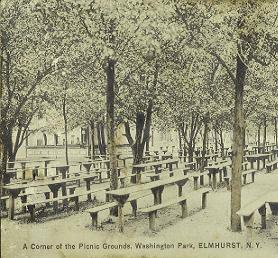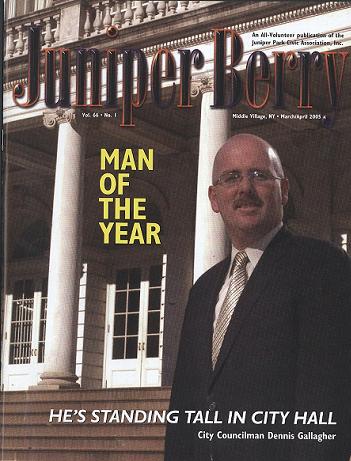With the growth of cemeteries in Queens because of changes in the burial laws, prosperity came to the Middle Village area in the form of travelers to the many funerals that were taking place.
Since travel time was so lengthy in the 1800’s cemetery visitors would arrive at their destination tired and hungry,
often ready to spend the night, before returning to New York City. Local residents in each town saw the need to
accommodate the visitors and as a result hotels, stables, restaurants and inns began to spring up within close
proximity to the cemeteries. The most famous of these was Niederstein’s Restaurant in Middle Village. This very old hotel began its career as the Grand Hotel of Judge Gustave Schumacher in 1845. The Judge was a local man with a huge following of friends and other influential businessmen. His home was on Grandview Avenue, facing Metropolitan Avenue, near the gate house to the Linden Hill Cemetery of the Central Synagogue.
When Judge Schumacher passed away, the Grand Hotel became referred to as the widow Schumacher’s hotel. When Schumacher’s widow, Catherine, later married a local marble yard operator named John Sutter, the Grand Hotel became known as Mrs. Catherine Sutter’s Hotel.
In later years around 1888, John Niederstein Sr. became the new owner of the Grand Hotel and during his stewardship he enlarged the hotel tremendously. Business was lucrative during John Niederstein’s tenure because he had new and innovative ideas on how to treat travelers. Food added to the hotel’s success since, before he emigrated to the United States, John Niederstein was a chef to the Kaiser in his native Germany. Another innovative addition by Niederstein was to place a large cage full of monkeys in the rear of the hotel.
This attraction served as entertainment for children who were accompanying their parents to the cemeteries.
Niederstein’s operated in the same successful manner for many years with its wooden floors scrubbed clean daily, and German food expertly prepared by talented cooks. The high standards set by John Niederstein Sr. continued until, sadly Niederstein’s doors closed forever on February 5, 2005, the end of an era of fine dining in Middle Village.
At the same time that industry was leaping ahead in Newtown township, cemeteries expanding, and hotels carrying on a brisk trade with travelers, there was yet another business developing in our community. The age of the Picnic Park was emerging, and people from the city as well as nearby residents flocked to the beer gardens, dance pavilions, lakes, ball fields and beautiful lawns of these Picnic Parks.
Picnic parks became popular in the late 1800s for the immigrant residents of the Greater Ridgewood area who worked six days a week and needed a form of entertainment. The Parks were located on direct routes of transportation along Metropolitan Avenue, Flushing and Grand Avenues and were designed to attract those who left the ferries at Williamsburgh and ventured by the horse cars to spend a day in the country of Newtown township.
The success of the picnic parks carried over into Maspeth and parts of Middle Village. One of the first was Clinton Park, owned and operated by DeWitt Clinton (Governor) of Maspeth.
Another was Monteverde’s Grand Street Park located on Grand and 69 Street, site of the old car barns and now the Long Island Expressway.
This park was owned by Maspeth resident, Judge William Monteverde. Monteverde’s Grand Street Park was used in numerous ways since it was the site of the annual camping grounds of the Grand Army of the Republic and training ground for the Brooklyn Athletic Club and the National Athletic Club. Firework displays also took place at this site sponsored by the Italian Clubs. There was Elmgrove Park, further along Grand Avenue, Mariondale Park which was in the vicinity of Jefferson Avenue and 53rd Avenue (old 73rd Street), and Washington Park, also on Grand Avenue (on the north side from 74th Street to 79th Street.
At the other end of Maspeth was Feldman’s Pavilion, later a fight club and in Zeidlerville were Ibert’s Park, and Wieman’s Park, (later Schnoor’s).
Around 1874 Schumacher’s Park was located at Flushing and Metropolitan Avenues. In the 1890’s Schumacher’s was known as Metropolitan Park and Hotel and, in later years a casino and banquet hall were added.
The industrial area of west Maspeth, on Maspeth Avenue, near Maspeth Creek was the site of Feldman’s Queens County Park. The clubhouse became a fight arena early in the 1920s. By the turn of the century the great era of the picnic parks was dwindling because another form of entertainment was being established, Coney Island.
Coney Island’s increasing popularity grew when train service to the amusement area began in 1920 but sky rocketing land values in the area also contributed to the popularity. There was a large influx of Germans migrating from Brooklyn and Yorkville as well as immigrants from Europe who needed housing. Demand became so great that builders had a difficult time trying to build homes fast enough to meet the demand.
Another factor was prohibition during 1920 to 1933 and beer sold in the picnic parks was a great favorite with the patrons. But when laws were passed reducing the alcohol content of beer to almost a water level, business waned.
Some of the great parks began to be dismantled and the lands put up for auction to make way for housing. The demise of these great places of entertainment signified to many the passing of the Victorian Age.



